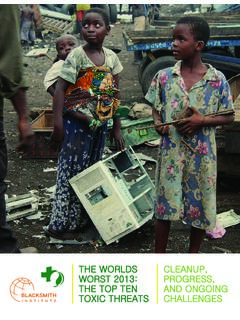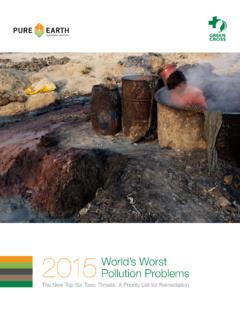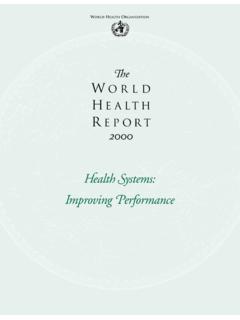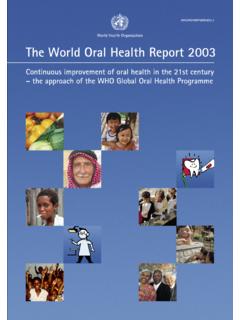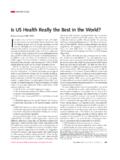Transcription of The World’s Worst Pollution Problems
1 The world 's Worst Pollution Problems : Assessing health Risks at Hazardous Waste Sites This document was prepared by the staff of Blacksmith Institute in partnership with Green Cross Switzerland with input and review from a number of experts and volunteers, to whom we are most grateful. Contributions: Sara Mills-Knapp, MS. Kira Traore Bret Ericson, MSc John Keith, MS. David Hanrahan, MSc Jack Caravanos, DrPH. Special Thanks To: Nathalie Gysi, Stephan Robinson, Andrea Walter, Triple Smart, Blacksmith Institute Technical Advisory Board Members, Blacksmith Institute staff, and Green Cross Switzerland staff.
2 For questions, comments and feedback, please contact: Blacksmith Institute 475 Riverside Drive New York, NY 10115. 1 (212) 647-8330. Media inquiries should be directed to Bret Ericson, Media inquiries in Europe should be directed to Nathalie Gysi: Green Cross Switzerland Fabrikstrasse 17. 8005 Zurich, Switzerland +41 (0) 43 499 13 10. This report is available online at Table of Contents Executive Introduction About the Scope of the Toxic Pollution and Human health ..8. What can be done?..9. Global Burden of Disease and DALYs Global health Burden of Toxic Calculating DALYs - Disability Adjusted Life Years (DALYs).
3 10. Applying DALYs Pollutant: Pollutant: Pollutant: Pollutant: The Top Ten List Lead-Acid Battery Lead Mining and Ore Tannery Industrial/Municipal Dump Industrial Artisanal Gold Product Chemical Dye The Remaining Five Sources Petrochemical Electronic Waste Heavy Pesticide Manufacturing, Storage and Use in Uranium Executive Summary The world 's Worst Pollution Problems : Assessing health Risks at Hazardous Waste Sites report reveals that close to 125 million people are at risk from toxic Pollution across 49 low to middle-income countries. Also, the report , for the first time estimates the total global burden of disease attributed to toxic Pollution from industrial sites in these countries.
4 It establishes the global burden of disease from toxic Pollution as on par with better-known public health Problems such as malaria and tuberculosis. Previous world 's Worst Pollution reports have ranked Pollution sources by the potential number of people at risk (2010) and created disease burden estimates for location-specific case studies (2011). This year's report is the first attempt at creating a widespread estimate of disease burden attributable to toxic Pollution from industrial sources. Previous estimates from these reports indicated that the at-risk population was in the range of 100 million people.
5 Over the past year Blacksmith Institute's extended efforts in new countries identified hundreds of more toxic Pollution sites. Based on this work, we are certain that the types of issues we look at affect millions more than we could previously confirm. It is important to note that this number is necessarily an underestimate of some magnitude and we anticipate these numbers growing significantly as more sites are identified. Based on Blacksmith Institute's investigations and observations, as well as the research of others, it is clear that the impact on health in low and middle income countries from these sites is very significant and likely higher than in the developed world .
6 4 The world 's Worst Pollution Problems 2012. There are several general underlying reasons for this: Poor regulation and oversight of those industries using hazardous substances and generating hazardous wastes Poor practices for control of hazardous wastes and emissions, coupled often with poor or no technology for management and treatment of wastes and emissions The presence of hazardous industries close to or within densely populated areas The local communities and industry operators limited understanding of the potential health impacts from exposure to hazardous wastes and emissions. The large role of small-scale enterprises in emitting toxic substances.
7 These operations are often in the informal economy and have limited financial resources to implement best practices. This year's report extrapolates from Blacksmith Institute's existing database of contaminated sites and creates a Top Ten List of Industrial Sources ranking industries based on the contribution of toxic pollutants to the global burden of disease. The sources of industrial pollutants presented in the 2012 report are placed in broad categories used by the Blacksmith Institute's database and may differ slightly in name only from past reports. All source types are comparable to past reports.
8 Top Ten List by DALY. (Disability-Adjusted Life Year) Blacksmith Institute found that the public Rank Industry DALYs health impact of industrial pollutants, measured in DALYs, is the same or higher 1. Lead-Acid Battery Recycling 4,800,000. than some of the most dangerous diseases 2. Lead Smelting 2,600,000. worldwide. Below is a comparison of the 3. Mining and Ore Processing 2,521,600 DALYs for HIV/AIDS, tuberculosis and malaria 4. Tannery Operations 1,930,000 to the DALYs from industrial pollutants. 5. Industrial/Municipal Dump Sites 1,234,000. DALYs comparisson 6. Industrial Estates 1,060,000. 7. Artisanal Gold Mining 1,021,000 Industrial Pollutants 17,147,600.
9 8. Product Manufacturing 786,000 Tuberculosis 25,041,000. 9. Chemical Manufacturing 765,000 HIV/AIDS 28,933,000. 10. Dye Industry 430,000 Malaria 14,252,000. These numbers are by no means conclusive but can be taken as indicative of the potential scale of the problem . Appropriately, large amounts of time and resources are devoted to addressing the burden of HIV/. AIDS, tuberculosis and malaria. The striking fact is that international and local government action on these disease burdens greatly outpaces the attention given to toxic sites; which, as demonstrated in this report , contribute greatly to the global burden of disease.
10 5. Introduction About the report The 2012 world 's Worst Pollution Problems report sets out to quantify the human health impacts from major sources of hazardous Pollution in low to middle-income countries. In particular the focus is on sites in the developing world where toxic Pollution has occurred because of industrial This evaluation of industries and pollutants is based on data collected by the Blacksmith Institute and Green Cross Switzerland through investigations of Pollution hotspots around the world , principally abandoned ( legacy . or orphan ) sites and informal artisanal activities. This report is compiled using analysis of the Blacksmith Institute's site database and a review of industry research, statistics and peer-reviewed studies.
